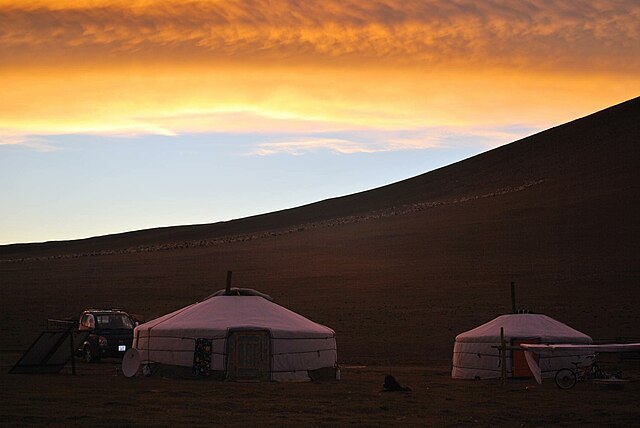The Mongol Empire in the 13th and 14th centuries was one of the largest land empires in history. Initially ruled by Mongol tribes following traditional Mongolian shamanism and tribal customs, the empire eventually adopted Islam as the main state religion during the early 14th century. This conversion brought about significant changes politically, culturally, economically that transformed the fabric of the mighty domain.
Background on the Rise of the Mongol Empire
Before analyzing the impacts of Islamization, it is helpful to understand the background on the meteoric rise of the Mongols. During the late 12th century, Temüjin, later known as Genghis Khan, united the nomadic Mongol tribes located in modern-day Mongolia and northern China. He created a fearsome cavalry army and implemented innovative military tactics using mobility and speed to overwhelm opponents.
Genghis Khan and his successors (his sons and grandsons) expanded Mongol rule rapidly outwards in all directions through brutal conquests. By 1279, the Mongols had subjugated most of Eurasia, conquering modern-day China, Central Asia, Persia, Russia, and Eastern Europe. This enormous empire connected trade routes and enabled commerce between Asia and Europe.
The founder Genghis Khan followed Mongolian shamanist beliefs emphasizing the importance of the Eternal Blue Sky and spirits. But he displayed religious tolerance towards the variety of faiths in his empire including Buddhism, Christianity, Manichaeism and Islam.

The Emergence of Islamization
Islam began making steady inroads among the Mongols starting in the 1250s under Mongke Khan. As more trade occurred between the Mongols, Persians and Arabs, Mongol leaders and soldiers gradually converted to Islam for practical reasons relating to commerce and alliances.
Hülegü Khan, a grandson of Genghis Khan, played a pivotal role in the Islamization process. In 1256, led an invasion capturing Baghdad, defeating the Abbasid Caliphate and occupying Persia. This brought the Mongols into greater contact with advanced Persian and Mesopotamian civilizations that had mathematical, medical and scientific knowledge lacking in Mongolia.
Intermarriages between Mongol khans and Persian and Turkic princesses also contributed to conversion. Eventually, all four khanates making up the Mongol Empire adopted Islam while Yuan China followed different religious trends.

Impacts of Islamization on Politics and Governance
The adoption of Islam led to impactful changes in how the Mongol domains were governed politically:
-
Increased Centralization and Bureaucracy - The Mongol imperial structure shifted away from decentralized separate khanates towards more unified caliphate-style rule focused around Persia. As Islam spread, the khans brought in more administrators from the Middle East to manage their territories.
-
Growing Power of Viziers - With greater bureaucracy, powerful viziers emerged to oversee administrative and legal affairs. Some viziers exerted substantial influence over khans, shaping policy decisions in Persia, Central Asia and the Il-Khanate domain of the Mongols.
-
New Tax Policies - Islam forbids taxing fellow Muslims. As more Mongols converted, it complicated tax collection used to fund military campaigns which were essential for holding the vast empire together against external and internal threats. Attempts were made to impose taxes on religious minorities like Christians.
-
Opposition from Mongol Traditionalists - The Mongol aristocracy included influential leaders and groups who resisted abandoning the traditional shamanist beliefs in favor of Islam, seen as undermining Mongol identity. Periodic persecutions of Muslim converts occurred, along with purges of Persian administrators seeking power.
-
Ruling as Islamic Khanates/Sultanates - As the descendants of Genghis Khan became genuine converts to Islam, they transitioned from ruling as Khans to taking on Islamic political titles like Sultan and Padishah to bolster religious credentials. For instance the Il-Khanate leaders later called themselves Padishah.

Cultural and Linguistic Changes
Converting to Islam also affected Mongol culture and languages in Central Asia, Persia and Russia:
-
Patronage of Islamic Architecture/Art - Instead of mainly nomadic culture, the Mongol elite increasingly adopted aspects of Persian and Mesopotamian urban society. Islamic architectural styles (mosques, madrassas, intricate crafts) were promoted by the Il-Khanate and Golden Horde leaders.
-
Promoting Persian Language - Persian culture and the Persian language became influential in Il-Khanate Mongol domains in Persia and Mesopotamia. Works of Persian literature, poetry, historical writing and early Islamic philosophy were translated and distributed.
-
Blending Nomadic Customs - The Mongols held onto some nomadic hunter/warrior traditions and customs relating to archery, horsemanship, falconry etc. These were blended with Islamic and urban Persian culture. Traditional Mongol principles like meritocracy and religious tolerance also endured.
-
Turkicization in Central Asia - In the Chagatai Khanate of Central Asia, the Mongol khans and nobles increasingly adopted Turkic culture and language. Through intermarriage between Mongol and Turkic nobility, Turkic gradually became the main spoken vernacular.

Economic Changes and Continuity
Economically, Islamization both altered certain policies but maintained some core Mongol practices:
-
Disruptions from Banning Alcohol - Mongols had brewed and consumed airag (fermented horse milk) and other alcoholic drinks as part of customs. The Islamic prohibition on alcohol caused disruptions with Mongol pastoral culture.
-
Livestock Focus - Animal husbandry relating to horses and sheep remained vital in the economies of Central Asia and the Steppe. Herding practices proved compatible with Islam and enabled trade in horses, wool and cheese.
-
Caravan Taxation - Taxing trade caravans traveling through Mongol territory provided state revenue. As more Mongols became Muslim, the focus shifted from taxing co-religionists towards extracting revenue from foreign Christian merchants and haulers like the famed Sogdian traders.
-
Continued Overland Trade - Merchant travel along the legendary Silk Road between China, Persia and European Russia stayed active under the Pax Mongolica system of Mongol rule. Trade enriched Il-Khanate domains which connected East with Islamic West.
-
Paper Money Usage - One notable economic innovation the Mongols adopted from China was issuing early paper currency. This simplified finance and trade as paper money backed by bullion spread across khans’ territories. The practice meshed with Islamic financial principles.
So in summary, Islamization strengthened Persian and Islamic influences in culture, politics and economics within Mongol society. But the Mongols also retained aspects of their nomadic heritage and customs during this transformation process. The blended fusion empowered the Mongols to be flexible rulers administering an extremely diverse Eurasian empire.

Frequently Asked Questions
What were some of the main reasons why the Mongols converted to Islam over other religions?
Some key reasons why Islam resonated with the Mongols more than faiths like Christianity, Buddhism or Chinese religions include:
- Cultural exposure and intermarriage between Mongol men and Persian and Turkic women
- Practical diplomatic and trade connections between Mongols and Muslim communities like Arabs, Persians
- Appeal of Sufi mystics and merchants that traveled among the Mongols
- Mongol leaders prior positive encounters with advanced Islamic based civilizations
Also Mongol rulers likely recognized adopting Islam would provide them more legitimacy to rule over majority Muslim subjects across Central Asia, Persia and the Middle East.
How long did the full process of Mongol conversion to Islam take?
The Islamization of the Mongols took place gradually over the course of almost 100 years - from the 1250s when first Mongol leaders converted through the 1330s-1350s as territories like the Golden Horde and the Chagatai Khanate became officially Muslim states. However, decades later Mongol descendents like Timur tried to revive Mongol culture and identity.
What were some negative impacts of Mongols converting to Islam?
Several damaging effects related to Mongols conversion include:
- Tensions and violence between traditional Mongol shamans and converts to Islam
- Conflicts between Mongols over loyalty to Islamic leaders like the Abbasid Caliphate vs Mongol Khans
- Loss of uniqueness of Mongol identity and dissolution into Islamic culture
- Higher administrative expenses from Muslim officials and expenses relating to mosques, religious schools etc.
So there were costs in terms of cultural integrity and cohesion from the religious transformation.
Why were many Mongol nobles and khans originally reluctant to embrace Islam?
The Mongol elite including followers of Genghis Khan had concerns about giving up their ethnic folk religion centered around shamans communicating with the Eternal Blue Sky. They feared losing traditions at the heart of Mongol heritage tied to archery, horsemanship and hunting.
Sources
“Mongol Empire.” Encyclopædia Britannica, Encyclopædia Britannica, Inc., https://www.britannica.com/place/Mongol-empire. Accessed 24 Jan. 2024.
“Islam and the Mongols.” Wikipedia, Wikimedia Foundation, 17 Dec. 2022, https://en.wikipedia.org/wiki/Islam_and_the_Mongols. Accessed 24 Jan. 2024.
“Religion in the Mongol Empire.” Wikipedia, Wikimedia Foundation, 3 Jan. 2023, https://en.wikipedia.org/wiki/Religion_in_the_Mongol_Empire. Accessed 24 Jan. 2024.
“Conversion of Mongols to Islam.” Wikipedia, Wikimedia Foundation, 18 Jan. 2023, https://en.wikipedia.org/wiki/Conversion_of_Mongols_to_Islam. Accessed 24 Jan. 2024.